How to Transform Your Sunroom into a Wisconsin Winter Greenhouse
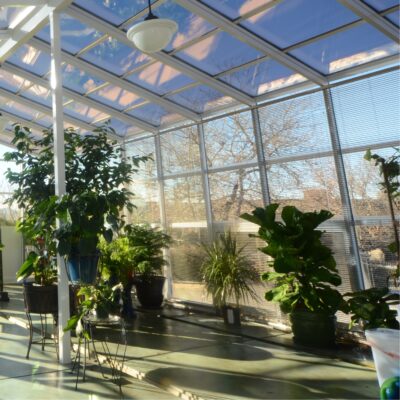 Yes, you read that right — it really is possible to turn your sunroom into a greenhouse this winter. In this article we show you how.
Yes, you read that right — it really is possible to turn your sunroom into a greenhouse this winter. In this article we show you how.
In addition to being able to care for and enjoy what you grow in your greenhouse, there’s also the benefit of how uplifting it is to see life growing right in your home — even on the coldest, dreariest of days.
Before we get into the details regarding all the essentials needed for a successful sunroom greenhouse, you’ll need to answer the following question …
Does My Sunroom Provide Enough Sunlight?
Keeping in mind that the sun shines far less during our Wisconsin winters, it’s important to discern a few things before choosing the type of plant life you want to cultivate in your greenhouse.
- South-facing greenhouses typically get more sunlight, which means the sun’s heat will warm up the room more and you won’t need to use an additional heating source as often — although you will likely still need one in place to ensure healthy growth of the plant life.
- If your sunroom is not south facing, or you simply want to plant greenery that doesn’t need as much sun, we recommend talking with your local plantsperson to discuss options.
- In general, sunroom greenhouses that face east are good for growing low-light crops, while sunroom greenhouses that face west are typically better suited for “heat-loving” crops.
Once you have some basic information, including which direction your sunroom faces and what types of greenery or crops you’d like to grow, your local plantsperson should be able to give you some good recommendations as to how to proceed.
Some Technical Considerations …
- Full access to light, and limited shade is ideal for plant growth.
- A minimum of 6 hours or light, each day, is advisable for proper growth and health of plants during winter months.
- You’ll need a heating source to ensure the greenhouse remains above a certain temperature, especially during the night. We advise talking about heating sources with the company that installed your sunroom, as they can recommend options that are effective, and also adhere to building codes.
Essentials for your Sunroom Greenhouse
There are some things a greenhouse just can’t do without (beyond the sun).
The following is a list of some essentials you need …
- A water supply: this can be as simple as a nearby sink to fill your watering can, or access to a hose.
- Insect repellent is something we’ve seen recommended for greenhouse sunrooms, although we suggest discussing options with your palntsperson. The last thing you want is anything toxic in your home.
- Benches & Seating: here’s a chance to get creative and add design elements to the greenhouse that match the style of your sunroom. The type of benches (for your plants), and seating (for you and your family) you choose, and how you arrange them, can go a long way in creating a greenhouse that’s pleasant to the eye.
- UV lights: perfect for when the days are cold and cloudy, UV lights can help promote plant health.
- Heating source: as mentioned earlier, keeping your greenhouse at a certain temperature is super important!
- Something else fun is adding brick plant stands and tables to the greenhouse environment, as they can absorb heat energy.
We hope these tips are helpful. If you need assistance transforming your sunroom into a greenhouse, or would like to discuss having a sunroom built for your home, feel free to contact us anytime to discuss things further!
How to Heat Your Outdoor Living Space During the Wisconsin Winter
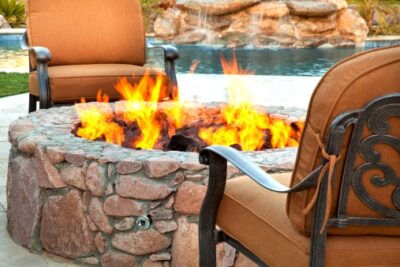 Enjoying your outdoor living space doesn’t need to be interrupted by the Wisconsin cold. So whether you would like to add a heating element to an existing outdoor living space, or are considering having a new one built for you, the following tips can help you stay cozy outside as the temperature drops.
Enjoying your outdoor living space doesn’t need to be interrupted by the Wisconsin cold. So whether you would like to add a heating element to an existing outdoor living space, or are considering having a new one built for you, the following tips can help you stay cozy outside as the temperature drops.
An important note: if you’re looking to add one of these heating elements to an existing outdoor living space, it’s important to speak with your contractor to ensure that what you’re planning is a safe solution for your deck, patio, screen porch or other exterior space — and is installed according to all current building codes.
That being said, let’s take a look at how to effectively heat your outdoor living space …
1. Natural Wood-Burning Fireplace
The warmth and wonderful smell of a natural wood-burning fireplace just can’t be beat — especially if you like the traditional aesthetic of this heating option. Installation and operation of a natural wood-burning fireplace is one of the more expensive outdoor heating options, so if cost is a consideration you may want to choose a more economical (yet still effective) solution.
2. Custom Outdoor Fireplace
This type of fireplace provides more design flexibility, making it possible to better suit the aesthetic of your outdoor living space, and your home. And you can choose from many materials including brick, stone, concrete — or even metal — and a custom outdoor fireplace can be fueled with gas or wood.
3. Biofuel Fireplaces
An alternative to wood-burning and gas fireplaces, a biofuel fireplace is an eco-friendly option that offers an extremely modern look. Fueled by bioethanol, a biofuel fireplace does not require a flue or chimney, so installation is easy and more flexible compared to traditional heating options. And as you might imagine, biofuel is clean burning.
4. Fire Pits
A flexible option, fire pits can be built right into the ground, or integrated into your outdoor living space. It’s also highly customizable. Perfect for cozy backyard campfires, and conversations with family and friends — and of course roasting marshmallows.
5. Gas or Propane Fire Pits & Fireplaces
Offering a more contemporary design, these outdoor heating options provide the same type of setup as their wood-burning counterparts, without the expense of using natural wood. In addition, while for some wood burning is an integral part of the experience, for others it’s just a hassle. If this is the case for you, a gas or propane solution may be just what you’re looking for.
6. Gas Lamps
Offering an industrial aesthetic, gas lamps are typically used in more commercial settings. That being said, as long as a gas or propane line is present, they can also be used in residential settings. Gas lamps need to have proper ventilation in place to operate.
7. Radiant Heating System
This heating system is built to keep snow and ice from accumulating on the flooring of your outdoor living space. It can also be incorporated into walkways — or even your driveway! Say goodbye to snow and ice accumulation (which means no shoveling), and say hello to clear, safe access to outdoor spaces.
Want to learn more?
Whether you’re interested in a new outdoor living space, or just have questions about the best way to heat it during the colder months, feel free to contact us anytime to discuss things further!
How to Winterize Your Patio
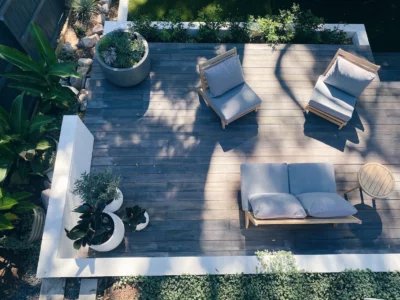 Patios can provide a lot of enjoyment, and winterizing them can go a long way in keeping them in tip-top condition for years to come. That’s why we want to share five ways on how to winterize a patio. These tips are perfect for new homeowners, and a great refresher for long-time homeowners.
Patios can provide a lot of enjoyment, and winterizing them can go a long way in keeping them in tip-top condition for years to come. That’s why we want to share five ways on how to winterize a patio. These tips are perfect for new homeowners, and a great refresher for long-time homeowners.
Without further adieu, let’s dive into our winterizing tips …
1. Weather-Proof Furniture
If you plan on using your patio during the colder Wisconsin months, weatherproofing your furniture, or simply purchasing furniture that’s weatherproofed is a good idea.
- Use waterproof fabrics for outdoor cushions, so water is easy to wipe away.
- Use coated/weatherproof tables and chairs, so wood does not rot and metal does not rust.
- Clean your cushions before that nasty weather sets in, as it helps prevent staining and discoloration.
- Invest in winter furniture covers to keep the elements at bay — be sure to cover each piece of furniture tightly for a better seal.
- If you’re NOT planning on using your patio during late fall and winter — store it (you’ll still want to clean it first, though).
- Store planters in the garage.
- Winterize your patio umbrella by folding it up, and wiping it down with a clean cloth to remove debris to ensure it looks fresh and clean next season.
2. Deep Clean Your Barbecue
Next spring, you’ll be glad you took the time to perform a good cleaning of your barbecue now …
- Carefully remove stuck-on grease and food from the grill.
- Although there are many grill cleaners on the market, we suggest simply soaking them in our sink for a while with hot soapy water to get all the build up off … It’s safer, and often easier
- When cleaning a gas grill, double check that the gas is fully turned off an that gas lines are properly disconnected.
- Store propane tanks in a cool, dry place.
Note: Please refer to your grill’s instructions for exact details on how to store unused fuel safely. - Once it’s clean, be sure to get your grill off the patio and store it in a safe place. If you choose to leave your grill outside, be sure to use a quality all-weather grill cover and make sure it’s nice and snug to protect the grill from the elements — and from wildlife.
3. Waterproof Your Patio
Following this advice can save you headaches and money down the road.
- Seal up wood decks with a quality sealant. This will prevent moisture from seeping into your wood deck, and can protect your deck boards for up to 10 years!
- Before applying sealant, be sure to sand your deck to bare wood and seal exposed grain with epoxy before applying the waterproofing coating.
- If your patio is made of masonry, be sure to seal it, too! Ice, snow and rock salt can damage this type of material by getting into cracks and crevices
4. General Cleaning & Precautions
Whether or not your patio is due for a waterproofing, it’s always a good idea to do some basic cleaning.
- Remove dirt, leaves, and anything else that’s made its way onto your patio.
- And do the same for the gutters around your patio (in addition to the rest of the gutters around your home). If gutters are not clean and clear, unwanted water can spill off onto the patio floor and cause damage.
- Turn off outdoor water valves and run the water out of them so pipes don’t freeze
5. Winterize a Patio Door
Since sliding doors can allow unwanted cold air into your home, follow these suggestions to keep out the cold.
- Maintain your sliding doors. To do this, examine the doors (both inside and out) to ensure there isn’t dirt, debris or pebbles in the tracks. Also check to make sure silicone glass seals look good and that the wood frame that surrounds the glass is not damaged or rotted (this can happen over time due to condensation)
- Add weather stripping if it’s not already present
- Insulated drapes or vertical blinds can also help keep drafts at bay
We hope these tips on how to winterize a patio help.
Stay warm this winter!
Are You Ready for an All-season Room?
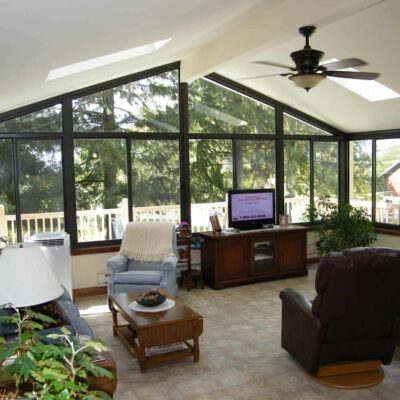 Whether you currently have a deck, 3-season room, screen room — or are planning your first outdoor living space, an all-season room may be an excellent choice for your home and family.
Whether you currently have a deck, 3-season room, screen room — or are planning your first outdoor living space, an all-season room may be an excellent choice for your home and family.
To help you discern if an all-season room is right for you, we’ve pulled together the top eight reasons most people choose to have one added onto their home. If these resonate with you, then an all-season room — or an all-season sunroom — may be the right solution for you.
Before we get into the top benefits, it’s important to note that usage needs and aesthetic preferences can be wildly different from person to person, so there’s no right (or wrong) answer regarding what outdoor living space is best for you. The one thing you’ll want to make sure of is that you choose a contractor with a proven track record of creating well-made, beauriful outdoor living spaces.
Now, onto the list of benefits …
The Top Eight Benefits of an All-season Room
- You control the temperature — year round!
No matter what the temperature is outside, you will be able to easily control the temperature inside your all-season room, regardless of whether it’s a blistering summer day, or a blustering Wisconsin winter storm. - Bugs won’t bug you
Enjoy the feeling of being outdoors without the bother of bugs. Enjoy meals, music, reading — or simply put your feet up, in the bug-free comfort of an all-season room. - Stay dry, even when it’s raining
Stay protected from the rain (and the snow!), and plan an event or gathering without having to worry about the forecast. No matter what, you’ll stay dry and comfortable. Plus, an all-season room protects your outdoor furniture, too! - More Functional Space
During our initial conversations with homeowners we’ll often hear them say they want more space — no matter what the size of their home! An all-season room gives you year-round access to more living space for leisure time, entertaining, or a wonderful work environment. - Entertainment
Speaking of entertaining, an all-season room can be a spectacular solution to entertain guests, celebrate a holiday or host a party. And just like you, your guests can enjoy every single benefit listed in this article making the gathering that much more memorable. - It can increase the value of your home
In addition to the enjoyment and comfort you experience from an all-season room, it can also increase the value of your home if you decide to sell. - The view is spectacular
When it comes to an all-season room, seeing is believing — and that’s exactly what you get to do from the comfort of the room. You can stay connected to nature year round with a spectacular view. And if you choose an all-season sunroom, you can also enjoy the sky and the stars. - More light!
The amount of additional natural light that an all-season room welcomes into your home can really brighten up the house. Once again, if you choose an all-season sunroom, there’s even more light to be enjoyed. Either choice has been known to lower energy bills because you don’t need to turn on artificial lights as often.
The Difference Between an All-season Room & an All-season Sunroom …
Throughout this article we’ve made reference to both types of year-round rooms.
But what’s the difference?
Essentially, the major difference between an all-season room and an all-season sunroom is the roof. Specifically, all-season rooms have a more traditional roof, while all-season sunrooms have a glass roof.
Want to learn more?
Check out our all-season rooms and all-season sunrooms pages for more details. You can also contact us anytime with questions or to set up an appointment to discuss things further!
Enjoy a Maintenance-free Pergola with Kynar 500™ Coating
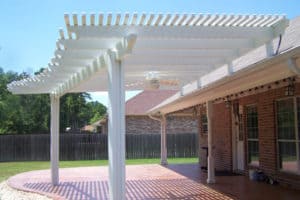 A pergola is a beautiful, budget-friendly upgrade that can enhance the enjoyment, curb appeal and value of your home.
A pergola is a beautiful, budget-friendly upgrade that can enhance the enjoyment, curb appeal and value of your home.
Pergolas are also versatile, as they can cover a patio, driveway, or an outdoor dining space — to name just a few of the solutions a pergola is perfect for. Since pergolas are designed to provide partial shade to the areas they cover, one of the benefits you can enjoy is just the right amount of shade and comfort for relaxing or a gathering with friends and family.
That being said, there are many types of materials that can be used for pergolas including cedar, vinyl and aluminum — each of which comes with its own level of maintenance.
That said, if you don’t like the idea of having to maintain your pergola — there is a solution that allows you to enjoy your pergola with little to no upkeep.
It’s called Kynar 500, and when it’s added as a coating to an aluminum pergola, the result is a maintenance-free experience.
How Kynar 500 Works …
Also used on metal roofing because of its extreme durability, Kynar 500 is an oven-baked, resin-based coating used to prevent aluminum, aluminized steel and galvanized steel from premature aging, chalking, pitting, weathering, pollution and chipping. It can withstand the blistering sun, acid rain, humidity, corrosive salt, as well as abrasion — and maintain its original color for decades.
Other benefits include resistance to mildew, fungus and it easily repels dirt, too!
Kynar is a powder coating, but it is intrinsically different then less durable powder coatings because it is “thermoplastic” instead of “thermoset.” Kynar is also applied at a greater thickness than most thermoset powder coatings, which is one of the factors that makes it so durable and protective of the aluminum substrate it’s baked onto. In contrast, over time other coatings begin to fail when they start to break down because of the effects of sun, rain, pollutants, etc., which is why they require maintenance.
Because of these outstanding qualities, Kynar 500 is often used by architects and builders to add longevity to a build. In fact, it was introduced in 1965 as the original high-performance finish for architectural metal, and is still considered the architect’s first choice today.
In addition to being maintenance free and long lasting (on average, for about 50 years), Kynar is also available in a variety of colors to complement the aesthetic of your home.
Want to learn more?
Feel free to check out our pergolas overview page. You can also contact us anytime with questions or to set up an appointment to discuss things further!
All-season Glass Roof Sunrooms are Spectacular & Versatile
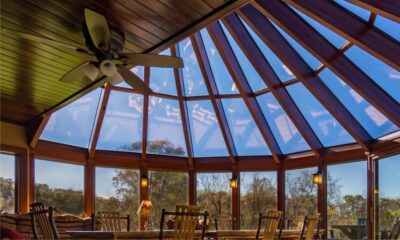 There’s something special about the look and energy of an all-season glass roof sunroom — not to mention the enjoyment of being able to look up at the sky, any time of year no matter what the temperature, from the comfort of the inside of your home.
There’s something special about the look and energy of an all-season glass roof sunroom — not to mention the enjoyment of being able to look up at the sky, any time of year no matter what the temperature, from the comfort of the inside of your home.
Since you’re here, you’re probably already considering an all-season glass roof sunroom, so let’s take a look at four different types to help you decide which one you like best.
No matter which all-season sunroom style you choose, just know they all provide year-round enjoyment!
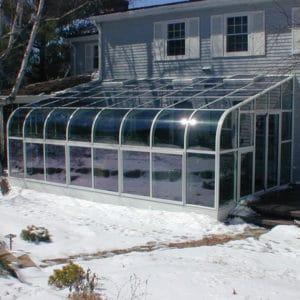 All-Season Curved Sunrooms
All-Season Curved Sunrooms
Offering a refined, classic look, these curved sunrooms have a seamless, graceful eave where the roof meets the wall. In addition to tons of natural light, this type of sunroom also creates elegant symmetry that can complement your home’s existing roofline.
Regarding materials, you can choose from a slim, contemporary aluminum profile, or warm, natural Northern White Pine beams. Another consideration is the type of windows that will be installed. At Kool View, we use our exclusive, patented, multi-coated CONSERVAGLASS SELECT™ windows by Four Seasons™, for year-round enjoyment you won’t find anywhere else.
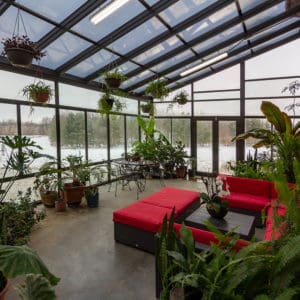 All-Season Studio Sunrooms
All-Season Studio Sunrooms
This type of sunroom is known for its affordable, single-sloped roof style — which adapts to nearly any existing roof design. In fact, all-season studio sunrooms are typically the most economical style of sunroom — and the most versatile. It can be used as an additional living room, pool enclosure, office or entertainment space!
Traditionally, materials used to build these sunrooms include wood and aluminum, although at Kool View we now offer a new hybrid vinyl sunroom material, as well.
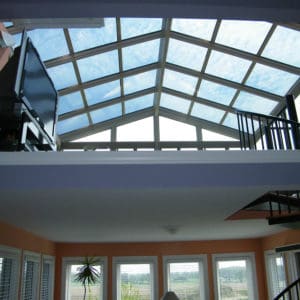 All-Season Cathedral Sunrooms
All-Season Cathedral Sunrooms
Breathtaking, vaulted cathedral sunroom ceilings are truly a sight to see. And, in addition to increasing the size of your living space, another big benefit of an all-season cathedral sunroom is return on investment. Local Madison, WI, realtors say this sunroom style delivers one of the highest returns on your investment: nearly 80%!
Perfect for family time, or a large holiday gathering, this type of sunroom is available in wood and aluminum. Kool View also offers a new hybrid vinyl material as an option.
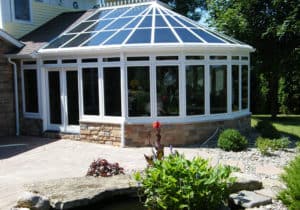 All-Season Conservancy & Gable Sunrooms
All-Season Conservancy & Gable Sunrooms
Conservatory sunrooms just might be the most well known type of sunroom.
With roots in European tradition, they offer old-world charm with the benefit of modern, energy-efficient, maintenance-free construction.
If you are looking for a beautiful sunroom that combines classic, elegant architecture with modern, durable construction, then an all-season conservatory sunroom from Kool View might be the perfect fit for you! Enjoy more light in a space that’s perfect for an enclosed pool, green house — or any room you want to bring the outdoors into, without the hassles of bugs and allergies.
These types of all-season sunrooms offer three materials options: aluminum, wood and vinyl. Kool View all-season conservatory and gable sunrooms feature our Four Seasons Conserva Glass Plus™ roofs for year-round comfort and performance.
Want to learn more?
Feel free to check out our Sunrooms Overview page, or one of the specific sunrooms pages under the Products & Galleries section of our navigation. You can also contact us anytime with questions or to set up an appointment to discuss things further!
Cedar vs. Aluminum — Which Pergolas Material is Your Best Choice?
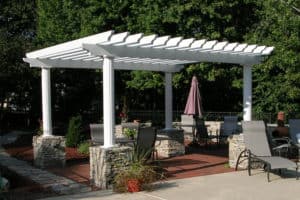 Pergolas are an affordable way to improve the look and enjoyment of your backyard, which makes them a popular choice among Dane County homeowners.
Pergolas are an affordable way to improve the look and enjoyment of your backyard, which makes them a popular choice among Dane County homeowners.
In this article, we’re going to look at two different pergolas materials — cedarwood and aluminum — to help you determine which option is your best choice. That said, it’s important to note that there is no one right choice for everybody. Budget, aesthetic and other project details, like the actual size of the pergolas being built, are all factors in the decision-making project.
Let’s Begin with Cost
Cedarwood pergolas typically cost less than aluminum pergolas, which can be a benefit IF you are willing to perform the necessary maintenance. As you’ll see, aluminum pergolas are practically maintenance free, lowering your time investment to keep them in excellent shape. Our customers overwhelmingly prefer maintenance-free aluminum pergolas, which is why it’s the only pergolas product we offer.
That said, let’s dive into some of the characteristics of these two pergolas materials, as well as the pros and cons of each.
Aluminum Pergolas
Sturdy and stable, aluminum pergolas tend to have a more modern, elegant look as compared to cedar pergolas. They’re also highly customizable and include a nice range of color options, textured coating options, as well as a wide variety of accessories — all of which contribute to your pergolas looking just right, so it perfectly complements the aesthetic of your home.
Maintenance free, and long lasting, aluminum pergolas stand the test of time, and Wisconsin weather for years of enjoyment. This is accomplished, in part, by powder coating the paint on the aluminum, which is a process that makes the paint job durable and resilient.
In addition, the Elitewood™ aluminum pergolas we build are coated with a multi-layer finish that repels dirt, controls fading and gives a hard, scratch-resistant finish that will look new for years. They have a wood grain, embossed finish for that authentic wood look.
An aluminum pergola also holds its shape and dimensions better than a cedar pergola, which can warp, crack or bow over time.
If you want the beauty of a pergola with a more modern feel — without the need for maintenance — then an aluminum pergola is an excellent choice.
Cedarwood Pergolas
When it comes to wood pergolas, we’re going to focus only on cedarwood. Yes, there are other wood options, including pressure-treated wood, tropical hardwood and modified wood, but for our purposes here we’re going to stick with cedar since it’s a material that best balances cost and durability, making it well suited for an outdoor environment.
Note: Western red cedar is a common type of cedar used for pergolas, and redwood is also popular. We mention this because these two types of wood are often considered the “same.” Although there are aesthetic differences between the two, both are naturally rot-resistant, insect-resistant and durable.
From an aesthetic point of view, cedar (or redwood) pergolas are going to provide a more rustic, natural look.
Unlike aluminum pergolas, cedarwood pergolas require regular maintenance. This is an important factor to keep in mind when choosing your pergolas material.
It’s also important to note that, compared to aluminum, cedar pergolas are better suited for large areas as the wood can span longer distances than aluminum without any structural compromise.
If you prefer a more rustic feel, a lower price tag, and don’t mind performing maintenance, a cedarwood pergola is an excellent choice.
Want to learn more?
Feel free to check out our pergolas overview page. You can also contact us anytime with questions or to set up an appointment to discuss things further!
The top 5 Benefits of Using V-series Windows for your 3-season Room
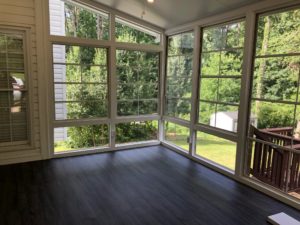 V-series windows are one of our most popular solutions for homeowners looking to turn their screen room, deck, porch or patio into a 3-season room.
V-series windows are one of our most popular solutions for homeowners looking to turn their screen room, deck, porch or patio into a 3-season room.
In this article, we’d like to share the top five reasons why they’re so popular to help you decide if this type of room is right for you. First, let’s define what a 3-season room is to make sure it’s what you’re looking for.
A 3-season room is exactly what it sounds like. It’s a room that can be enjoyed during spring, summer and fall. They’re built to last and look great for years. However, they’re not suitable for the Wisconsin winter months like an all-season room is. Learn more about the differences between a 3-season and all-season room.
In case you’re wondering, the “V” in V-series windows stands for vinyl — specifically memory vinyl, which is a specific type of vinyl that has the ability to revert to it’s original shape if stretched. Unfortunately, these windows won’t help improve your memory, but this material offers a lot of benefits …
The Top 5 Benefits of Using V-series Windows for Your 3-season Room
Affordability: Memory vinyl is less expensive than glass. That being said, it still provides protection from ultraviolet rays, rain, wind and pesky bugs. We’d also like to clarify that affordable does not mean cheap. As with everything Kool View creates, we only use top-notch materials that are built to last.
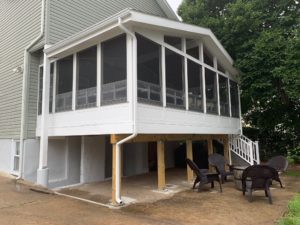 Versatility: V-series windows can be easily opened in a variety of ways to control air flow, and each window can be opened up to 75%, offering a lot of adjustability as the seasons change.
Versatility: V-series windows can be easily opened in a variety of ways to control air flow, and each window can be opened up to 75%, offering a lot of adjustability as the seasons change.
A few V-series window tips:
- Opening from the bottom provides the best breeze
- Opening from the top helps keep rain out, while still allowing air movement
- Opening from top AND bottom allows air movement — but you won’t feel a breeze!
Variety: What’s great about V-series windows is that there are some nice choices for frame and glaze colors, which gives you the ability to customize the look of your 3-season room — and also complement the rest of your home’s aesthetic. You can choose from five frame colors, and four glaze colors. An added benefit is that the frame and glaze colors you choose can also help set a mood, helping create a space that feels peaceful and calming. Plus glaze colors help control the amount of light that enters the room.
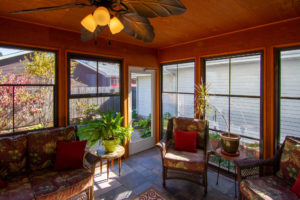 Two Screen Types: The standard screen type is ideal for letting in a cool, refreshing breeze. Our premium screen type is just as breezy, and offers pet paw resistance with “no-see-um” protection from mosquitoes, flies, gnats, etc.
Two Screen Types: The standard screen type is ideal for letting in a cool, refreshing breeze. Our premium screen type is just as breezy, and offers pet paw resistance with “no-see-um” protection from mosquitoes, flies, gnats, etc.
Durability: Tough memory vinyl and minimal moving parts are a recipe for durability, and ease of use, in your 3-season room.
We hope this overview of 3-season rooms made with V-series windows has been helpful!
Want to learn more?
Feel free to check out our V-series Windows page. You can also contact us anytime with questions or to set up an appointment to discuss things further!
What’s the Difference Between a 3-season and an All-season Room?
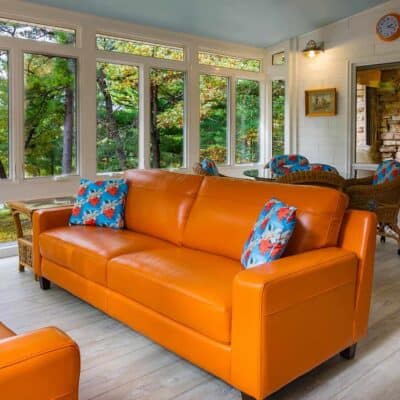 From an aesthetic point of view, there appears to be little difference between a 3-season and all-season room. Upon closer inspection, you’ll find that although the look is very similar there are some major differences — mostly in the materials used, including the framing system and the type of glass.
From an aesthetic point of view, there appears to be little difference between a 3-season and all-season room. Upon closer inspection, you’ll find that although the look is very similar there are some major differences — mostly in the materials used, including the framing system and the type of glass.
That said, both room types have the ability to keep the room heated and cooled. We mention this because people are sometimes more focused on staying warm in the cooler months, and are pleasantly surprised to learn that these rooms can keep you cooler in the warmer months, too!
What sets these two types of rooms apart is the amount of usage you will get from each.
A 3-season room is built with single-pane glass and non-insulated floors. We build them to last and look great for years to come, they’re just not suitable for Wisconsin winters. The reason is, single-pane glass and non-insulated floors don’t offer the same amount of climate control as the materials used in an all-season room. 3-season rooms are also built with non thermally-engineered frames that are extremely sturdy, but do not provide the same climate control benefits of the thermally-engineered frames found in all-season rooms.
Because of this, a 3-season room is an excellent choice if you’re not concerned with using your room during the coldest times of the year. It’s less expensive than an all-season room, just as lovely and equally well constructed.
It comes down to a question of usage vs. cost, which is something we discuss with our clients so they can make the best decision possible. The last thing we want a homeowner to do is spend too much for a room they don’t plan on using year round, or spending less only to regret not having the use of their room when the temperature drops.
TYPICAL USAGE: 3-season rooms are typically used in the spring, summer and fall.
An all-season room uses framing that is thermally engineered so the room can be cost-effectively heated and cooled year round. Use of double-pane glass and insulated floors are also major factors in creating a room that can be temperature controlled. In other words, an all-season room lets you effectively use an HVAC unit for either heating or cooling purposes — creating year-round comfort.
All-season rooms have two available options for framing:
- Vinyl with steel and aluminum reinforcement
- All aluminum
Both of these framing options are thermally-engineered.
Ultimately, if you want to be close to nature and the beauty of winter, without having to deal with the cold, an all-season room is an excellent choice.
When it comes to cost, all-season rooms tend to be more expensive than 3-season rooms because of the materials used.
TYPICAL USAGE: All-season rooms are built for year-round use, even during our frigid Dane County winters.
One final note: in case you were wondering, 3-season rooms can be upgraded to all-season rooms!
Want to learn more?
Feel free to check out our 3-season & all-season rooms page. You can also contact us anytime with questions or to set up an appointment to discuss things further.
Which Type of Screen Room is Right for You?
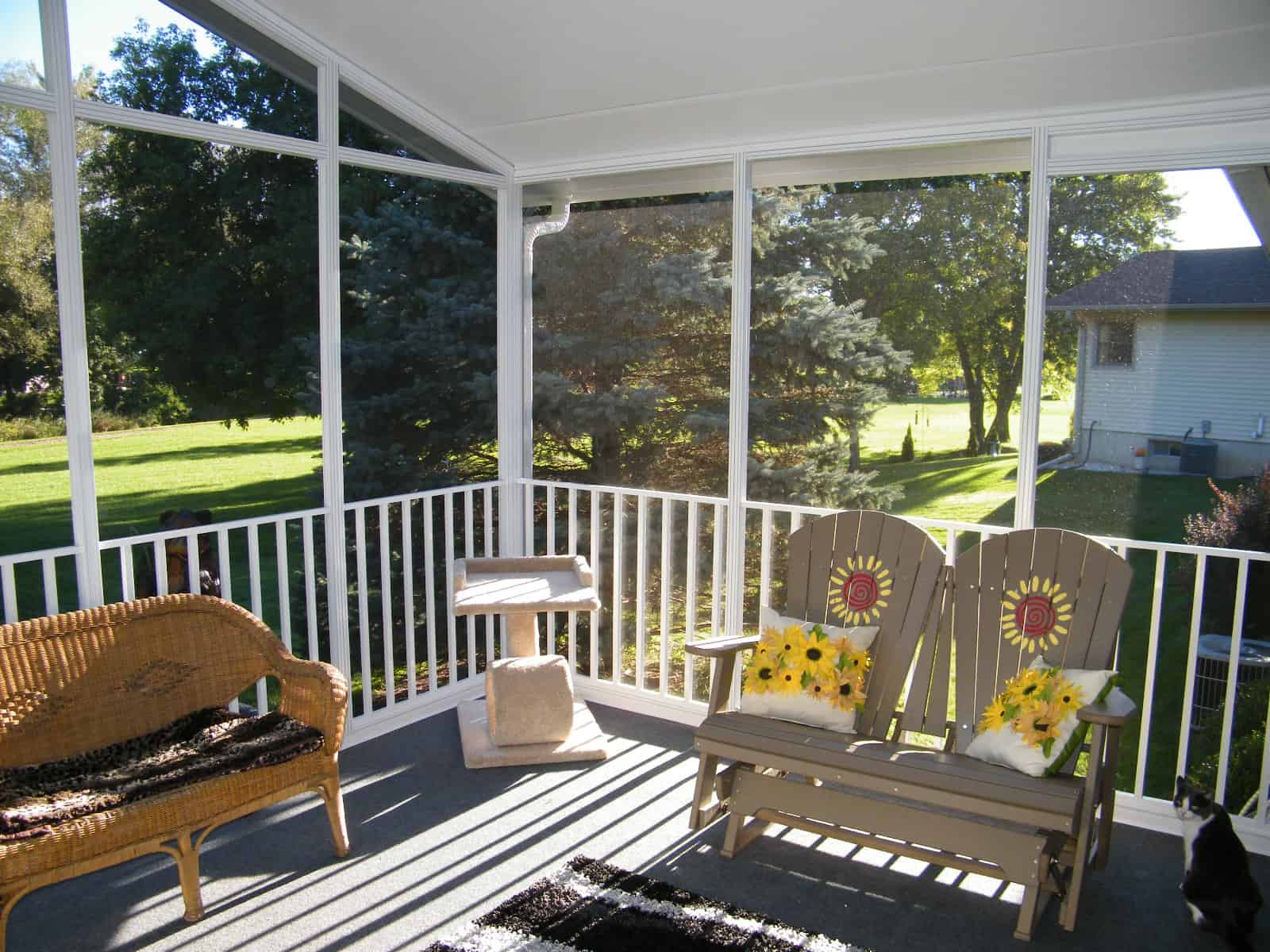 Thinking about a screen room for your home?
Thinking about a screen room for your home?
In this article, we’ll briefly define screen rooms and compare them to three and all season rooms to highlight the major differences between them. Then, we’ll dive into some of the more popular screen room options to see which one resonates with you.
SCREEN ROOMS DEFINED
Screen rooms are additions to your home that offer protection from rain, sun, bugs and wildlife. We like to call screen rooms “the ideal hybrid of outdoor enjoyment without outdoor hassles.” They’re also unique, affordable and an excellent way of extending your outside living area.
THREE SEASON AND ALL SEASON ROOMS
The biggest difference between a screen room vs. a three season or all season room is the fact that screen rooms have no glass, which means it does not offer protection from the cold.
Three season and all season rooms offer more usability as the cold weather sets in. Both have glass windows, and actually look quite similar to the eye. The only differences between a three and all season room are the TYPE of glass and flooring used. A three season room has single-pane glass and non-insulated floors, while an all season room makes use of double-pane glass and insulated floors, to effectively control the climate within the room.
TYPES OF SCREEN ROOMS
When choosing your screen room enclosure design, there are a lot of options. That said, there are three major design elements you will want to consider when making a decision about what type of screen room will most effectively meet your needs.
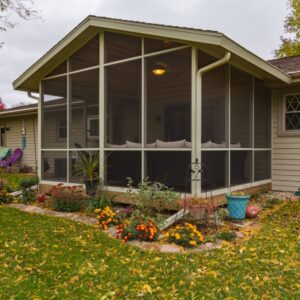
Full Screen
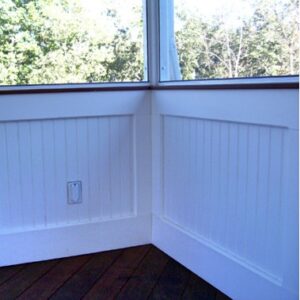
Knee Wall
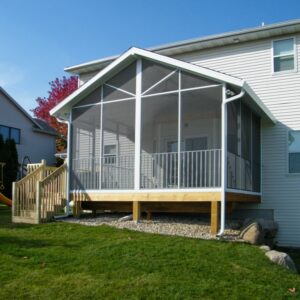
Picket
Full Screen Wall
This option offers the perfect outdoor feel — with a maximum view — while still effectively keeping insects out. You can also add a kick panel to keep out dirt, grass cuttings and other debris.
Solid Knee Wall
Designed with insulated laminated wall panels (LWP), this option makes it possible to upgrade your screen room enclosure to a glass patio enclosure at a later time.
Picket System
Provides a distinct look, and added safety when required by building codes.
In addition to these three architectural designs, you can also choose to customize your screen room further with many color and texture options, as well as gutters & downspouts.
TYPES OF SCREENS
And here is a list of many of the most popular screen choices …
Better View Screen
Like the name suggests, it’s easier to see through!
Pet Screen
Great for homes with pets, pet screens are claw- and tear-resistant.
SuperScreen
Used for large porch screens, this is one of the most durable screen cloths available.
Aluminum Screen
Most commonly used for window screens.
Solar Screen
Perfect for openings where direct sun is an issue, solar screens can also be used for privacy considerations.
Fiberglass Screen
Economical fiberglass screening does not crease or dent.
One more thing we’d like to share with you: make sure you are getting a quality product installed on your property. For instance, all of the screen rooms we build are framed with no-maintenance aluminum beams that are only 2 inches wide. This ensures a sturdy structure, and a better view!
Want to learn more?
Feel free to check out our screen rooms page. You can also contact us anytime with questions or to set up an appointment to discuss pergolas with you.